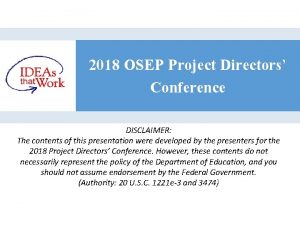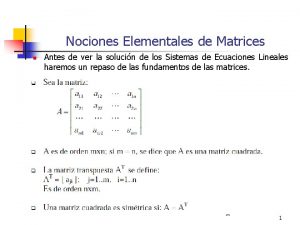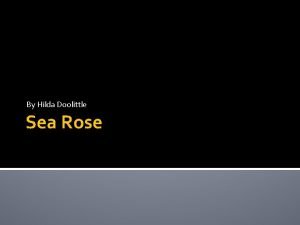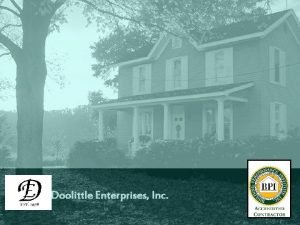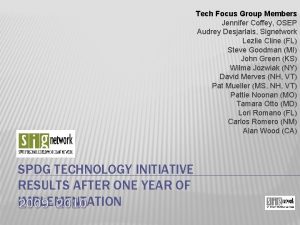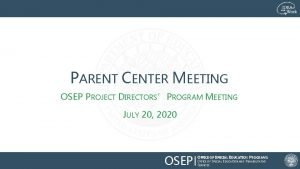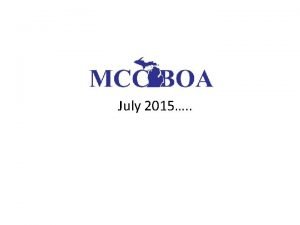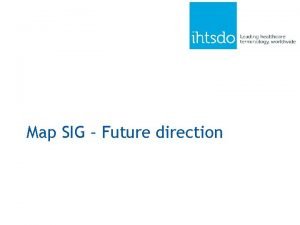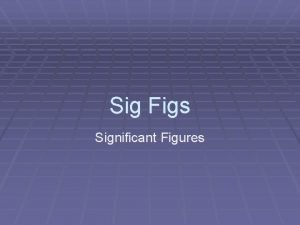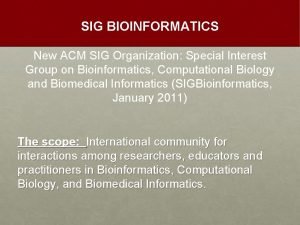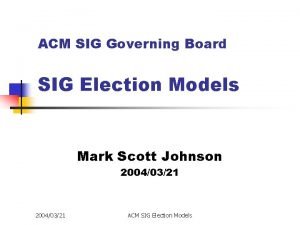SIG Day 2009 Jennifer Doolittle OSEP July 20















- Slides: 15

SIG Day 2009 Jennifer Doolittle OSEP July 20, 2009

The SPDG Program • • • SIGnetwork FY 2009 Budget Performance Measures Regional Meetings Working with Your Project Officer Implementation & Scaling Up Session

SIGnetwork • Listserv – If not currently on a Listserv, send your information to Audrey – Types of information provided through the listserv • • New SPDG competition announcement Continuation reporting reminders and tips Budget information Research and other resources • Web site: www. signetwork. org

FY 2009 Budget • Changes in activities • Consistent and timely expenditures – Fiscal monitoring • “Comparing spreadsheets” • Communication with contractors – TA from your Project Officer • Examples of successes • Thorough explanations in the continuation report

Performance Measures • Reference card • OSEP Program Measures are combined with GPRA Measures – Should be aligned with your objectives throughout your report • More methodology guidance is coming

SPDG Performance Reporting Tips • Annual Performance Reports (APRs): Deadlines for Annual Reports are important and must be met in order for the project to meet its reporting responsibilities and for OSEP to meet its organizational performance measures. The reports are required in order to allocate money to the states for continuing years. The report should focus on the performance measures and outcomes or accomplishments.

In addition, data provided for the PROGRAM Measures are used to determine the success of the SPDG Program. Although information about processes is important, data regarding outcomes are critical for your quantitative data tables. The desired outcomes you described in your application are the outcomes you should report in your APR. Submit Report Packages Per Directions in the “Dear Colleague” Letter. Project Objectives and Performance Measures: Project Objectives are what your project is doing to support the overall program goal (these should come from grant application). Performance measures are how you measure your progress toward meeting your objectives. OSEP PROGRAM performance measures should be aligned under appropriate project objectives. You must report annually on each PROGRAM measure, however the SPDG program evaluation data for the long-term measures will only be gathered from your final report.

Setting Targets: When reporting on quantitative performance measures, you are required to report on the targets (e. g. , benchmarks or goals) that you established in your approved grant application for each budget period, as well as your actual performance data for the budget period. If you did not establish targets in your approved grant application, please provide a detailed plan of how you will provide this information in future grant performance reports. If you did not establish targets in your approved grant application, but have established those targets after the award, either in consultation with your OSEP project officer or by identifying how you planned to provide this information in your previous annual performance report, please provide the data accordingly.

Final Reports: are due 90 days after the completion of the grant. The final reports are not built into the online report system. To complete the final report, download the continuation report and check the final report box. Focus on the performance measures and outcomes/accomplishments and include the budgetary information for the entire grant cycle. The Project Officer reviews the report before closing out the grant. If there is money remaining at the end of the grant cycle and the project still has objectives to fulfill, there is anoption to request a no-cost extension. Do not submit a final report if funds are still being spent. Filing for No-Cost Extension: There is no electronic form. You must notify your project officer in writing with the supporting reasons and revised expiration date at least 10 days before the project period end date.

Regional Meetings • Washington, DC: October 1 -2 • Kansas City, MO: Oct 5 -6 • Portland, OR: Oct. 14 -15 • Due dates:

Working with Your Project Officer • Changing activities • New personnel or changes in FTE – Must request approval for changes in key personnel or significant changes in FTE • Send resume of proposed personnel • • Questions about reporting Budgetary challenges Other challenges No cost extension – A one-time extension of the final budget period of an award for a period of up to 12 months, as authorized in EDGAR § 75. 261, unless law, regulations, or the grant terms and conditions specify otherwise. EDGAR § 74. 25(e) requires the grantee to notify ED of the intended extension at least ten days before the end of the budget period and give supporting reasons for the extension. ED can deny a no-cost extension under § 74. 25(e) if a grantee wants the extension simply to obligate unused funds after the objectives of the project have been met.

• Use of carryover funds for allowable activities or costs that fall within the scope and objectives of the project (see section 5. 4. 7, “Carryover”). • c. Pre-award costs or expenditures for allowable items and activities of a project for a period up to 90 days before the beginning of either a new award (EDGAR § 75. 263). See section 4. 3. 4, “Pre-Award Costs, ” for guidance on preaward cost proposed for periods greater than 90 days before the beginning of a project period. ) • d. ED cannot obligate additional funds to the grant for the extension or permit the grantee to conduct activities outside the scope and objectives of the approved project.

In Your Packet • • • SPDG Initiative Matrix Contact Directory (sorted by last name) Contact Directory (sorted by state) SPDG Program Measures half sheet Fall Regional Meeting Flyer Mentor/Mentee List

Implementation & Scaling Up Sessions (2: 15 – 3: 35 pm) • Implementation Drivers Group (pre-exploration to installation implementation stage in their initiative) – PRESENTERS: Allison Metz & Dean Fixsen (SISEP) – Taking a closer look at • Competency Drivers – Selection, Training, & Coaching, or • Organization Drivers – Decision Support Data System, Facilitative Administration, & Systems Intervention – Table discussions facilitated by State personnel currently working on scaling up

Readiness for Scaling Up Session • Initial implementation to innovation group – PRESENTER: Dean Fixsen – Table discussion will be facilitated by someone from your table – Focus on readiness for scaling up an innovation statewide
 Day 1 day 2 day 3 day 4
Day 1 day 2 day 3 day 4 July 30 2009 nasa
July 30 2009 nasa Osep syllabus
Osep syllabus Osep leak
Osep leak Harris burdick pictures missing in venice
Harris burdick pictures missing in venice Antwrp
Antwrp The mysteries of harris burdick a strange day in july
The mysteries of harris burdick a strange day in july Day 1 day 2 day 817
Day 1 day 2 day 817 Feng doolittle algorithm
Feng doolittle algorithm Feng doolittle algorithm
Feng doolittle algorithm Feng doolittle algorithm
Feng doolittle algorithm Hessiano orlado
Hessiano orlado Hd sea rose
Hd sea rose Doolittle enterprises
Doolittle enterprises Amity doolittle
Amity doolittle Oread by hilda doolittle
Oread by hilda doolittle


